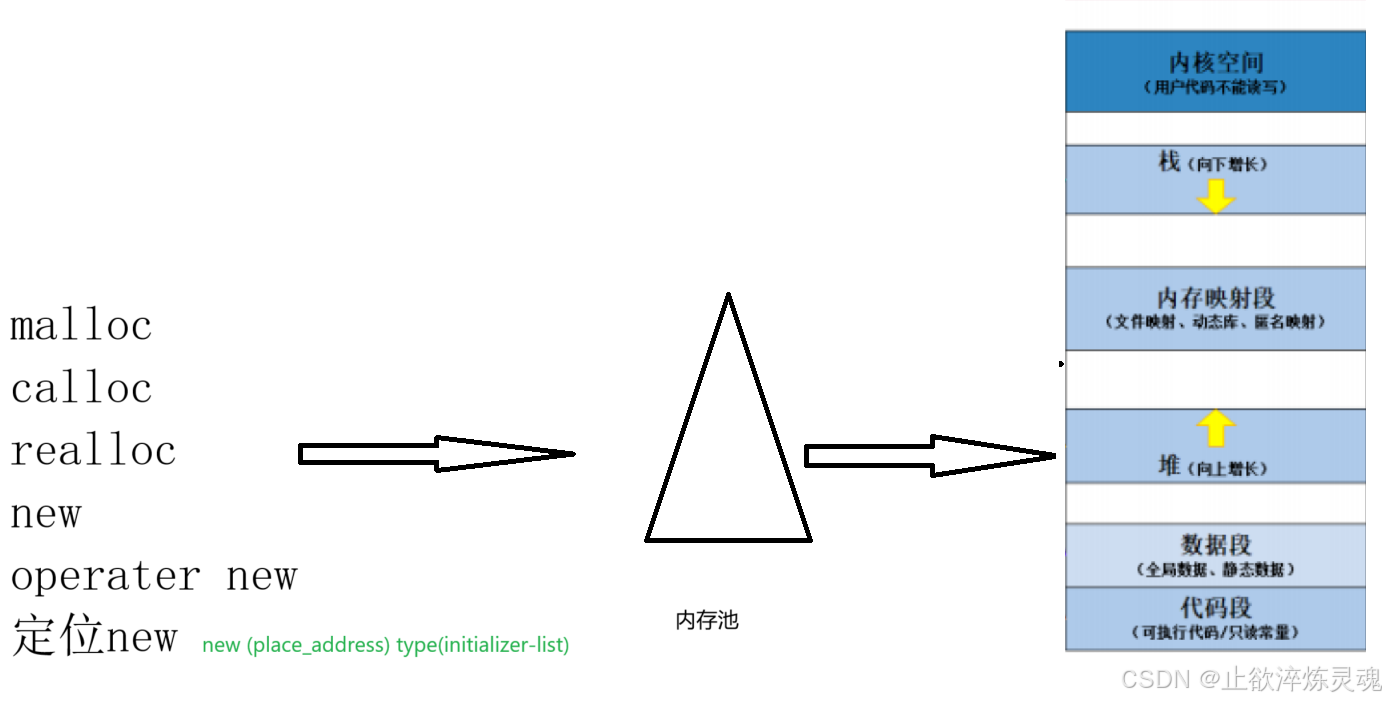动态内存分配与运算符重载
一、动态内存分配(一)内存的分类(二)动态内存分配函数(1)new 和delete 的使用(1)new 的原理(2)delete 的原理 2、 operator new与operator delete(1)operator new 的原理(2)operator delete 的原理 (三)定位new(四) malloc/free和new/delete的区别 二、操作符重载(一)输入输出重载(二)其它操作符重载结束语
一、动态内存分配
(一)内存的分类
在C/C++中,内存主要分为五个部分,其中我们之前C语言学习过程中的动态内存分配读取的堆区的内存。

(二)动态内存分配函数
(1)new 和delete 的使用
在动态内存分配是,通过控制台可以发现,堆区是向上增长的。同时也发现了new / delete 和 malloc / free 这组函数的区别,前者会申请后完成构造,释放时自动调用析构,而后者只做空间的申请。
class A{public:A(int a = 0): _a(a){cout << "A():" << this << endl;}~A(){cout << "~A():" << this << endl;}private:int _a;};int main() {cout << "内置类型:" << endl;int* p1 = new int;int* p2 = new int(1);int* p3 = new int[3];delete p1;delete p2;delete[] p3;cout << "自定义类型:" << endl;A* p4 = new A;A* p5 = new A(1);A* p6 = new A[3];delete p4;delete p5;delete[] p6;return 0;}
(1)new 的原理
通过汇编代码,可以清楚的发现,new 调用了 operator new 函数和构造函数

(2)delete 的原理
和new 一样,先调用了析构函数,后调用了 operater delete。

2、 operator new与operator delete
需要区分的是,new 和 delete是用户进行动态内存申请和释放的操作符,operator new 和operator delete是系统提供的全局函数,不是函数重载。new在底层调用operator new来申请空间,delete在底层通过operator delete来释放空间。
(1)operator new 的原理
通过下面代码,我们可以发现,operate new也是通过 malloc 来申请空间,相比于 malloc,不再通过返回值是否为空来判断申请的成功与否,而是抛异常的方式。
而在参数上面二者一致。
void* __CRTDECL operator new(size_t size) _THROW1(_STD bad_alloc){// try to allocate size bytesvoid* p;while ((p = malloc(size)) == 0)if (_callnewh(size) == 0){// report no memory// 如果申请内存失败了,这里会抛出bad_alloc 类型异常static const std::bad_alloc nomem;_RAISE(nomem);}return (p);}(2)operator delete 的原理
不难看出,delete 的底层也是采用free 实现,free 本质是一个宏。
void operator delete(void* pUserData){_CrtMemBlockHeader* pHead;RTCCALLBACK(_RTC_Free_hook, (pUserData, 0));if (pUserData == NULL)return;_mlock(_HEAP_LOCK); __TRYpHead = pHdr(pUserData);_ASSERTE(_BLOCK_TYPE_IS_VALID(pHead->nBlockUse));_free_dbg(pUserData, pHead->nBlockUse);__FINALLY_munlock(_HEAP_LOCK);__END_TRY_FINALLYreturn;}#define free(p) _free_dbg(p, _NORMAL_BLOCK)(三)定位new
如果我们想要将申请空间和构造函数、释放空间和析构函数分开调用,又该怎么办呢。我们知道构造函数不可以显示调用,此时可以用到定位new。
new (place_address) type或者new (place_address) type(initializer-list)
其中,place_address必须是一个指针,initializer-list是类型的初始化列表
A* object = (A*)malloc(sizeof(A));new(object)A(1);object->~A();free(object);A* object2 = (A*)operator new(sizeof(A));new(object2)A;object2->~A();free(object2);
在上面的代码中,采用malloc和operater new的唯一区别就是前者可以通过检查返回值查看是否开辟成功,而后者通过抛异常的方式检测。
(四) malloc/free和new/delete的区别
malloc和free是函数,new和delete是操作符malloc申请的空间不会初始化,new可以初始化malloc申请空间时,需要手动计算空间大小并传递,new只需在其后跟上空间的类型,多个对象在[]中指定对象个数malloc的返回值为void*, 在使用时必须强转,new不需要malloc申请空间失败时,返回的是NULL,因此使用时必须判空,new不需要,但是new需要捕获异常申请自定义类型对象时,malloc/free只会开辟空间,不会调用构造函数与析构函数,而new和delete会调用构造函数与析构函数。二、操作符重载
我们通过实现一个日期类来说明这部分知识。由于运算符重载并不复杂,挑选有特点的部分讲解。
运算符重载要点
1、可以利用运算符之间的联系来重载其它运算符。
2、对于不改变this 指针的运算符,可以考虑加上 const 否则一些const对象在调用时可能会造成权限的放大,导致错误
(一)输入输出重载
输入输出流重载中,只能写成全局函数。因为成员函数中存在隐藏的this 指针,而函数重载规定参数列表中的第一个参数是在运算符右边,如果写成成员函数就要反过来,老别扭了。
ostream& operator<<(ostream& out, const Date& d) {out << d._year << "年" << d._month << "月" << d._day << "日" << endl;return out;}istream& operator>>(istream & in, Date & d){while (1) {cout << "请输入年、月、日" << endl;in >> d._year >> d._month >> d._day;if (!d.check_date()) {cout << "日期不合法,请重新输入!" << endl;continue;}break;}return in;}(二)其它操作符重载
class Date {friend ostream& operator<<(ostream& out, const Date& data);friend istream& operator>>(istream& in, Date& d);public:Date(int year = 1, int month = 1, int day = 1);bool check_date() const;bool isRunNian() const;int getMonthDay(int month) const;void print_date() const;//比较运算符重载bool operator<(const Date& d) const; bool operator<=(const Date& d) const;bool operator>(const Date& d) const;bool operator>=(const Date& d) const;bool operator==(const Date& d) const;bool operator!=(const Date& d) const;//加减运算符重载Date& operator+=(int day);Date operator+(int day) const;Date& operator-=(int day);Date operator-(int day) const;int operator-(const Date& d) const;Date& operator++();Date operator++(int);Date& operator--();Date operator--(int);private:int _year;int _month;int _day;static int _month_day[13];};int Date::_month_day[13] = {0,31,28,31,30,31,30,31,31,30,31,30,31 };Date::Date(int year, int month, int day):_year(year), _month(month), _day(day){if (!check_date()) {cout << "日期不合法!" << endl;}}bool Date::check_date() const{if (_month > 12 || _month < 1)return false;else if (_day > getMonthDay(_month) || _day < 1) return false;else return true;}bool Date::isRunNian()const{if ((_year % 4 == 0 && _year % 100 != 0) || _year % 400 == 0)return true;else return false;}int Date::getMonthDay(int month) const{if (month == 2) {if (isRunNian()) return 29;}return _month_day[month];}void Date::print_date() const{cout << _year << '-' << _month << '-' << _day << endl;}bool Date::operator<(const Date& d) const {if (_year != d._year)return _year < d._year;else if (_month != d._month) return _month < d._month;else return _day < d._day;}bool Date::operator<=(const Date& d) const{return (*this < d || *this == d);}bool Date::operator>(const Date& d) const{return !(*this <= d);}bool Date::operator>=(const Date& d) const{return !(*this < d);}bool Date::operator==(const Date& d) const{return _year == d._year && _month == d._month && _day == d._day;}bool Date::operator!=(const Date& d) const{return !(*this == d);}Date& Date::operator+=(int day){_day += day;while (_day > getMonthDay(_month)) {_day -= getMonthDay(_month);if (++_month == 13) {_month = 1;_year += 1;}}return *this;}Date Date::operator+(int day) const{Date object(*this);object += day;return object;}Date& Date::operator-=(int day){_day -= day;while (_day < 1) {if (--_month == 0) {_month = 12;_year -= 1;}_day += getMonthDay(_month);}return *this;}Date Date::operator-(int day) const{Date object(*this);object -= day;return object;}int Date::operator-(const Date& d) const{Date max = *this;Date min = d;int flag = 1;if (max < min) {max = d;min = *this;flag = -1;}int n = 0;while (min != max) {min += 1;n++;}return n;}Date& Date::operator++(){return (*this += 1);}Date Date::operator++(int){Date temp(*this);*this += 1;return temp;}Date& Date::operator--(){return (*this -= 1);}Date Date::operator--(int){Date temp(*this);*this -= 1;return temp;}void test01(){Date object1(2024, 2, 29);Date object2(2024, 2, 18);Date object3(2024, 2, 18);if (object1 > object2) cout << "object1 < object2" << endl;if (object3 == object2) cout << "object3 == object2" << endl;}ostream& operator<<(ostream& out, const Date& d) {out << d._year << "年" << d._month << "月" << d._day << "日" << endl;return out;}istream& operator>>(istream & in, Date & d){while (1) {cout << "请输入年、月、日" << endl;in >> d._year >> d._month >> d._day;if (!d.check_date()) {cout << "日期不合法,请重新输入!" << endl;continue;}break;}return in;}void test02(){Date object1(1940, 10, 5);Date object2(2024, 8, 27);Date object3(2024, 9, 19);Date object4(2004, 7, 19);object4 += 7367;object4.print_date();object3 -= 7367;object3.print_date();cout << object3 - object4 << endl;cout << object2 - object1 << endl;object1++;object1.print_date();object1--;object1.print_date();结束语
小伙伴们,文章就先告一段落了,感谢各位长期以来的支持,博主就先撤啦!